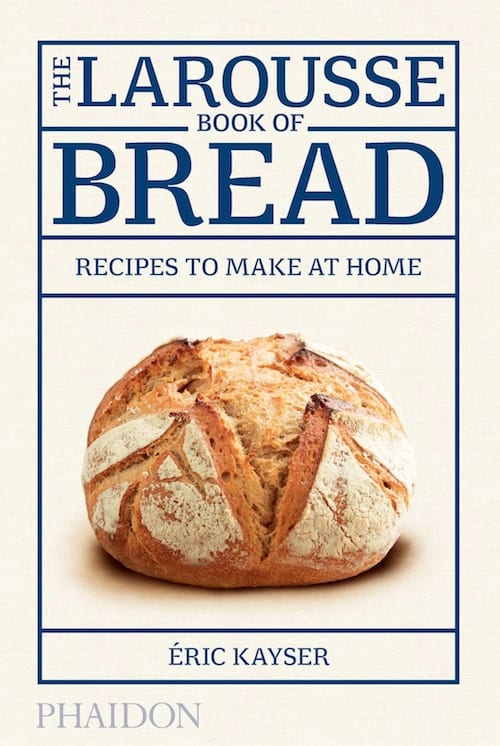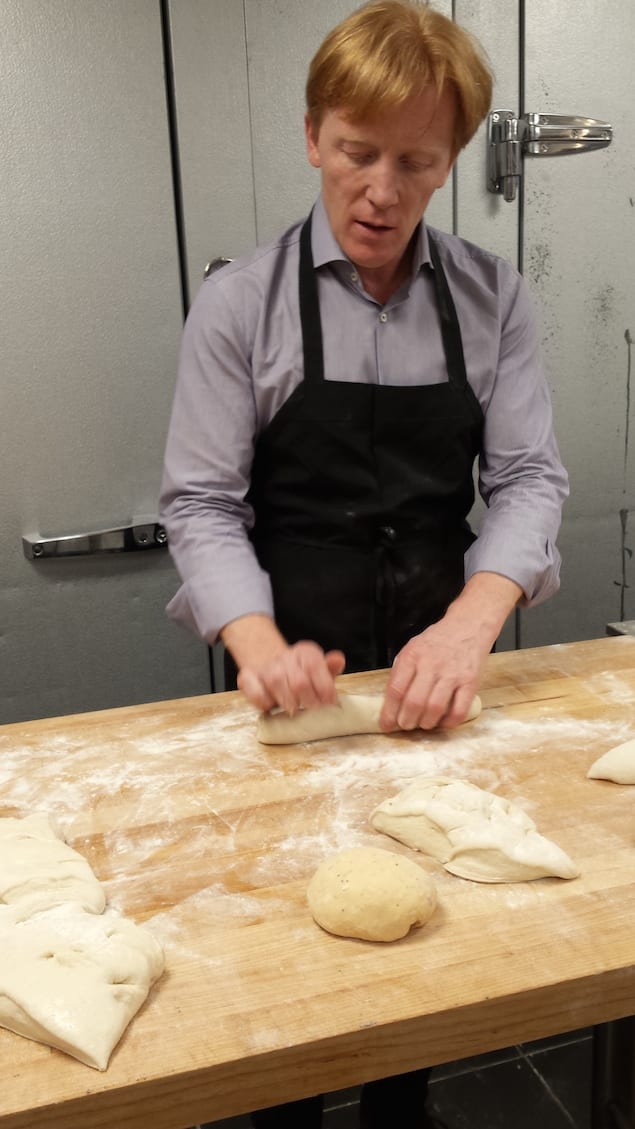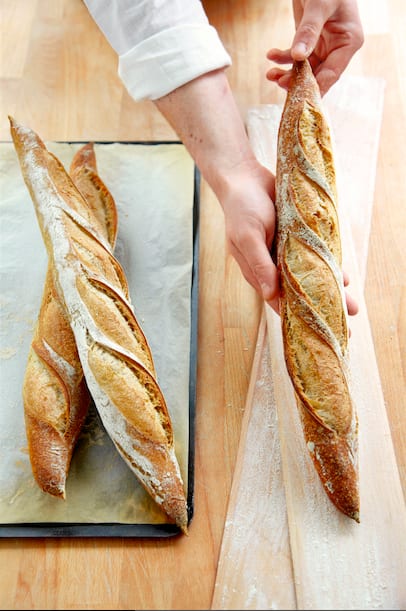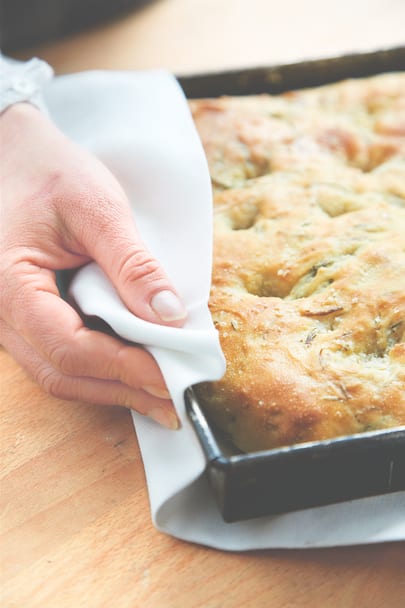Combining a love of writing and food, Andrew's culinary journey…
Famed French baker Éric Kayser has launched his new book, “The Larousse Book of Bread.” Meant for the home baker, the book breaks down different techniques and recipes to enjoy in the comfort of your own kitchen. Now you can feel like you’re deep in the heart of France, without actually going there.
By Andrew Asistin
 “The Larousse Book of Bread: Recipes to Make at Home” by Eric Kayser, Phaidon, 2015.
“The Larousse Book of Bread: Recipes to Make at Home” by Eric Kayser, Phaidon, 2015.
Hailed as one of the best bakers in France, Chef Éric Kayser has launched a brand new cookbook intended for the home cook. “The Larousse Book of Bread” houses over 80 recipes for breads and pastries, straight from the mind of Chef Éric. We had a chance to meet with chef while he was at Maison Kayser here in New York to preview the book and get a hands-on lesson in bread baking.
Chef Éric began by speaking briefly about his new book. He explained that he wanted to present the book in a way that home bakers could understand easily. Each recipe is presented in an easy-to-read, step-by-step fashion, accompanied by color photos. The recipes in the book start off on a fairly easy slope, explaining basic techniques such as kneading and shaping. As the book progresses, it delves into more complex recipes, such as oil-enriched breads;these include Ciabatta and Focaccia. Chef Éric’s knowledge is coming through clear as day in each page.
Once the presentation was over, Chef Éric began a tour of Maison Kayser’s bakery. It’s astounding just how much work is accomplished in such a small space, by only a handful of people. There weren’t that many specialized pieces of equipment either; only larger versions of mixers one would find in a home kitchen. What followed was a hands-on demonstration led by Chef Éric himself. He demonstrated how to roll and form a piece of dough into its final shape before baking. His hands moved in such a flurry, but with ease and precision. It was quite a sight to behold. As he worked, he explained that while his techniques looked complex, they weren’t. Far from it. He explained to us that the home baker could accomplish this, just as easily.
The book reads like something one would find in the bag of a culinary school student, only far more detailed and infinitely more interesting. Chef Éric goes out of his way to present the recipes and techniques in his book so that they are incredibly easy to understand. He shares decades of knowledge, distilled into excellent, easy-to-follow advice for the home baker. You can find a copy of the book for sale here.
Here are two recipes that stood out to us. They’re classic breads that should be in every home baker’s profile.
Photo from The Larousse Book of Bread (c) Massimo Pessina, courtesy of Phaidon
- 500g (4 cups) all-purpose (plain) flour, plus extra for dusting
- 325g (scant 1 1/3 cups) water at 68°f (20°c)
- 100g (scant 1/2 cup) liquid sourdough starter (or 25 g [3 tablespoons] dry sourdough starter)
- 3g (1 teaspoon) fresh baker’s yeast, crumbled
- 10g (2 teaspoons) salt
- Put the flour and water in the bowl and mix for 4 minutes at low speed.
- Remove the bowl from the machine and cover it with a damp cloth.
- Leave to rest for 1 hour, then add the starter, fresh yeast, and salt.
- Knead with the dough hook for 4 minutes at low speed, then for 7 minutes at high speed.
- Put the flour on a work surface or in a mixing bowl and make a large well in the center.
- Pour in two-thirds of the water and mix until all the flour has been incorporated.
- Leave to rest for 1 hour under a damp cloth, then incorporate the rest of the water, the starter, fresh yeast, and salt.
- Knead the dough until it becomes smooth and elastic.
- Shape into a ball and cover with a damp cloth.
- Let rise for 1 hour 30 minutes. It will have increased in volume by the end of the rising time.
- Dust the work surface. Divide the dough into 3 equal pieces.
- Fold each piece over on itself, pulling gently to stretch into a longish log.
- Cover with a damp cloth and leave to rest for 30 minutes.
- Working with 1 piece of dough at a time, use the palm of your hand to flatten it gently.
- With the long side facing you, fold in a third towards the center and press along the edge with your fingertips.
- Swivel the dough 180 degrees.
- Fold in the other long edge so that it overlaps in the center and press with the heel of your hand. Fold one half on top of the other, and seal the edges together with the heel of your hand
- With lightly floured hands, roll the baguette out to 21 inches (55 cm) long, then pinch each end into a point.
- Shape the other 2 baguettes the same way.
- Carefully lift the baguettes onto a lightly floured baker’s cloth, seams underneath.
- Separate them by making folds in the cloth.
- Cover with a damp cloth and leave to proof for 1 hour 40 minutes, by which time the baguettes will have increased in volume.
- Place a baking sheet on the bottom shelf of the oven and preheat to 450°f (230°c).
- Gently place the baguettes, seam down, on another baking sheet lined with parchment (baking) paper.
- Dust with flour and make 4 evenly spaced oblique slashes along the length of each baguette.
- Just before putting the baguettes in the oven, pour 50 g (scant 1/4 cup) of water onto the preheated baking sheet.
- Bake for 20 minutes. Remove from the oven and leave to cool on a wire rack.
Photo from The Larousse Book of Bread (c) Massimo Pessina, courtesy of Phaidon.
- 4–5 sprigs fresh rosemary
- 30 g (2 tablespoons) extra-virgin olive oil, plus extra for drizzling
- 500 g (4 cups) all-purpose (plain) flour
- 330 g (1 1/3 cup) water at 68°f (20°c)
- 100 g (scant 1/2 cup) liquid sourdough starter (or 25 g [2 tablespoons] dry sourdough starter)
- 7 g (2 1/2 teaspoons) fresh baker’s yeast
- 10 g (2 teaspoons) salt
- Sea salt flakes for sprinkling
- Put the flour, water, starter, yeast, and salt in the bowl.
- Knead with the dough hook for 5 minutes at low speed, then for 10 minutes at high speed.
- Add the rosemary and the steeping oil around 3 minutes before the end of the kneading time.
- Put the flour on a work surface or in a mixing bowl and make a large well in the center.
- Pour in half the water, then add the starter, fresh yeast, and salt.
- Mix well, then add the rest of the water and knead until all the flour has been incorporated.
- Add the rosemary and the steeping oil.
- Knead the dough until it becomes smooth and elastic
- Shape the dough into a ball, cover with a damp cloth, and leave to rise for 2 hours.
- Midway through the rise, deflate the dough by folding it in half.
- By the end of the rising time it will have increased in volume.
- Put the dough in a shallow baking pan lined with parchment (baking) paper.
- Stretch the dough with your hands to make a flat piece that fills a 16 × 12- inch (40 × 30- cm) pan. Cover with a damp cloth and leave to proof for 1 hour 30 minutes
- Place a baking sheet on the bottom shelf of the oven and preheat to 450°f (230°c).
- Use the tips of your fingers to press small holes over the surface of the focaccia
- Pour a little oil into the holes and sprinkle with salt flakes.
- Just before putting the focaccia in the oven, pour 50 g (scant 1/4 cup) of water onto the preheated baking sheet. Bake for 15–20 minutes.
- Remove from the oven, turn out the focaccia, and leave to cool on a wire rack.
Combining a love of writing and food, Andrew's culinary journey has walked many paths. From university, to the Culinary Institute of America, to the restaurants of NYC. Now finally settled in as an editorial intern at Alimentari, the next step of his journey can begin.








What is the substitute in grams or teaspoons of fresh baker’s yeast for dry instant yeast?